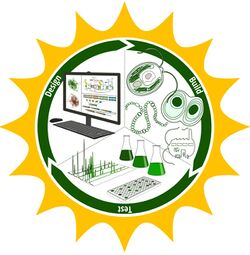Synthetic biology
(medical technology, biotechnology) | |
|---|---|
 | |
| Interest of | • Ginkgo Bioworks • Craig Venter |
| An area of research that seeks to create new biological parts, devices, and systems, or to redesign systems that are already found in nature. This contrasts with "traditional" genetically modified organisms created by transferring existing genes from one cell type to another. | |
Synthetic biology (SynBio) is an area of research that seeks to create new biological parts, devices, and systems, or to redesign systems that are already found in nature. This contrasts with "traditional" genetically modified organisms created by transferring existing genes from one cell type to another.
Major goals of synthetic biology include re-designing genes, cells, or organisms for gene therapy; development of minimal cells and artificial protocells; and development of organisms based on alternative biochemistry.[1]
This work has been driven by the development of genome synthesis and editing tools, as well as pools of standardized synthetic biological circuits with defined functions. The availability of these tools has spurred the expansion of a do-it-yourself biology movement.[2]
Synthetic biology has potential commercial applications in energy, agriculture, medicine, and the production of chemicals including pharmaceuticals.[1]
Due to more powerful genetic engineering capabilities and decreased DNA synthesis and sequencing costs, the field of synthetic biology is rapidly growing. In 2016, more than 350 companies across 40 countries were actively engaged in synthetic biology applications; all these companies had an estimated net worth of $3.9 billion in the global market.[3]
Biosecurity
The rise of synthetic biology has also spurred biosecurity concerns that synthetic or redesigned organisms could be engineered for bioterrorism[1], but given the resources needed to perform this kind of research it could only be done by a government or very rich people. However, synthetic biology could expand the group of people with relevant capabilities, and reduce the amount of time needed to develop them.[4]:2–7
A 2018 National Academies of Sciences, Engineering, and Medicine (NASEM) report identified three capabilities as being of greatest concern. The first is the recreation of known pathogens from scratch, for example using genome synthesis to recreate historical viruses such as the Spanish Flu virus or polio virus[5]. Current technology allows genome synthesis for almost any mammalian virus, the sequences of known human viruses are publicly available, and the procedure has relatively low cost and requires access to basic laboratory equipment. However, the pathogens would have known properties and could be mitigated by standard public health measures, and could be partially prevented by screening of commercially produced DNA molecules. In contrast to viruses, creating existing bacteria or completely novel pathogens from scratch was not yet possible as of 2018, and was considered a low risk.[4]:39–43, 54–56
Another capability of concern cited by NASEM is engineering existing pathogens to be more dangerous. This includes altering the targeted host or tissue, as well as enhancing the pathogen's replication, virulence, transmissibility, or stability; or its ability to produce toxins, reactivate from a dormant state, evade natural or vaccine-induced immunity, or evade detection. The NASEM considered engineered bacteria to be a higher risk than viruses because they are easier to manipulate and their genomes are more stable over time.[4]:5, 44–53
A final capability of concern cited by NASEM is engineering microbes to produce harmful biochemicals. Metabolic engineering of microorganisms is a well established field that has targeted production of fuels, chemicals, food ingredients, and pharmaceuticals, but it could be used to produce toxins, antimetabolites, controlled substances, explosives, or chemical weapons. This was considered to be a higher risk for naturally occurring substances than for artificial ones.[4]:59–65
There is also the possibility of novel threats that were considered lower risks by NASEM due to their technical challenges. Delivery of an engineered organism into the human microbiome has the challenges of delivery and persistence in the microbiome, though an attack would be difficult to detect and mitigate. Pathogens engineered to alter the human immune system by causing immunodeficiency, hyperreactivity, or autoimmunity, or to directly alter the human genome, were also considered lower-risk due to extreme technical challenges.[4]:65–83
References
- ↑ a b c https://blogs.cdc.gov/niosh-science-blog/2017/01/24/synthetic-biology/
- ↑ https://publications.europa.eu/en/publication-detail/-/publication/bfd7d06c-d3ae-11e5-a4b5-01aa75ed71a1/language-en
- ↑ https://doi.org/10.1016%2Fj.tibtech.2017.02.002 Bueso, F. Y.; Tangney, M. (2017). "Synthetic Biology in the Driving Seat of the Bioeconomy". Trends in Biotechnology. 35 (5): 373–378.
- ↑ a b c d e f https://doi.org/10.17226%2F24890 Biodefense in the Age of Synthetic Biology. National Academies of Sciences, Engineering, and Medicine. 2018-06-19. ISBN 9780309465182.
- ↑ http://www.hse.gov.uk/research/rrpdf/rr944.pdf
Wikipedia is not affiliated with Wikispooks. Original page source here